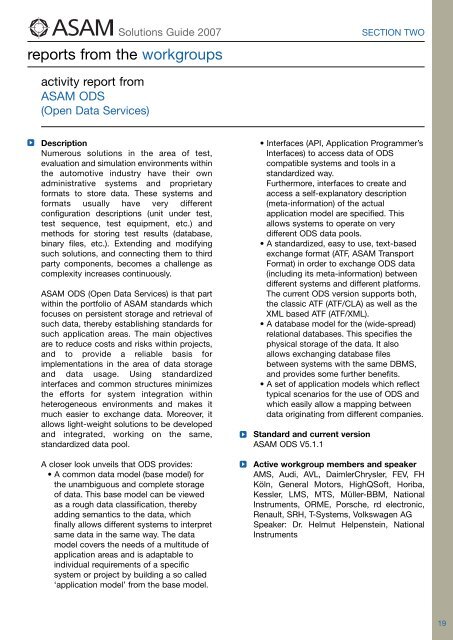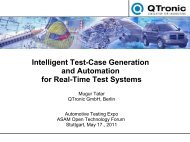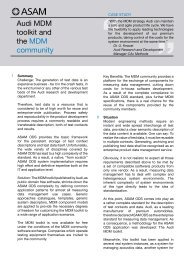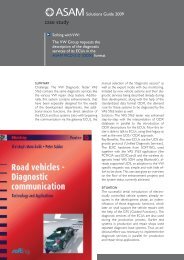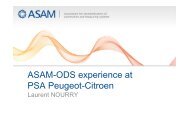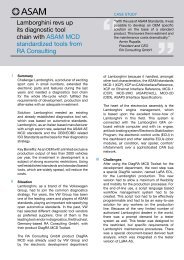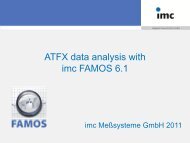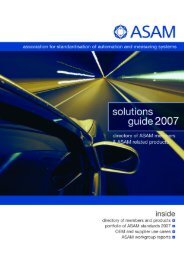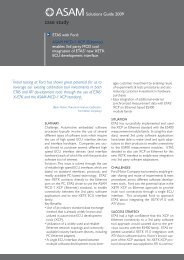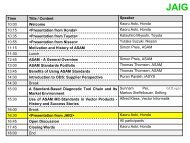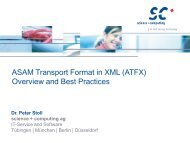You also want an ePaper? Increase the reach of your titles
YUMPU automatically turns print PDFs into web optimized ePapers that Google loves.
eports from the workgroups<br />
activity report from<br />
<strong>ASAM</strong> ODS<br />
(Open Data Services)<br />
Solutions Guide 2007 SECTION TWO<br />
Description<br />
Numerous solutions in the area of test,<br />
evaluation and simulation environments within<br />
the automotive industry have their own<br />
administrative systems and proprietary<br />
formats to store data. These systems and<br />
formats usually have very different<br />
configuration descriptions (unit under test,<br />
test sequence, test equipment, etc.) and<br />
methods for storing test results (database,<br />
binary files, etc.). Extending and modifying<br />
such solutions, and connecting them to third<br />
party components, becomes a challenge as<br />
complexity increases continuously.<br />
<strong>ASAM</strong> ODS (Open Data Services) is that part<br />
within the portfolio of <strong>ASAM</strong> standards which<br />
focuses on persistent storage and retrieval of<br />
such data, thereby establishing standards for<br />
such application areas. The main objectives<br />
are to reduce costs and risks within projects,<br />
and to provide a reliable basis for<br />
implementations in the area of data storage<br />
and data usage. Using standardized<br />
interfaces and common structures minimizes<br />
the efforts for system integration within<br />
heterogeneous environments and makes it<br />
much easier to exchange data. Moreover, it<br />
allows light-weight solutions to be developed<br />
and integrated, working on the same,<br />
standardized data pool.<br />
A closer look unveils that ODS provides:<br />
• A common data model (base model) for<br />
the unambiguous and complete storage<br />
of data. This base model can be viewed<br />
as a rough data classification, thereby<br />
adding semantics to the data, which<br />
finally allows different systems to interpret<br />
same data in the same way. The data<br />
model covers the needs of a multitude of<br />
application areas and is adaptable to<br />
individual requirements of a specific<br />
system or project by building a so called<br />
‘application model’ from the base model.<br />
• Interfaces (API, Application Programmer’s<br />
Interfaces) to access data of ODS<br />
compatible systems and tools in a<br />
standardized way.<br />
Furthermore, interfaces to create and<br />
access a self-explanatory description<br />
(meta-information) of the actual<br />
application model are specified. This<br />
allows systems to operate on very<br />
different ODS data pools.<br />
• A standardized, easy to use, text-based<br />
exchange format (ATF, <strong>ASAM</strong> Transport<br />
Format) in order to exchange ODS data<br />
(including its meta-information) between<br />
different systems and different platforms.<br />
The current ODS version supports both,<br />
the classic ATF (ATF/CLA) as well as the<br />
XML based ATF (ATF/XML).<br />
• A database model for the (wide-spread)<br />
relational databases. This specifies the<br />
physical storage of the data. It also<br />
allows exchanging database files<br />
between systems with the same DBMS,<br />
and provides some further benefits.<br />
• A set of application models which reflect<br />
typical scenarios for the use of ODS and<br />
which easily allow a mapping between<br />
data originating from different companies.<br />
Standard and current version<br />
<strong>ASAM</strong> ODS V5.1.1<br />
Active workgroup members and speaker<br />
AMS, Audi, AVL, DaimlerChrysler, FEV, FH<br />
Köln, General Motors, HighQSoft, Horiba,<br />
Kessler, LMS, MTS, Müller-BBM, National<br />
Instruments, ORME, Porsche, rd electronic,<br />
Renault, SRH, T-Systems, Volkswagen AG<br />
Speaker: Dr. Helmut Helpenstein, National<br />
Instruments<br />
19


